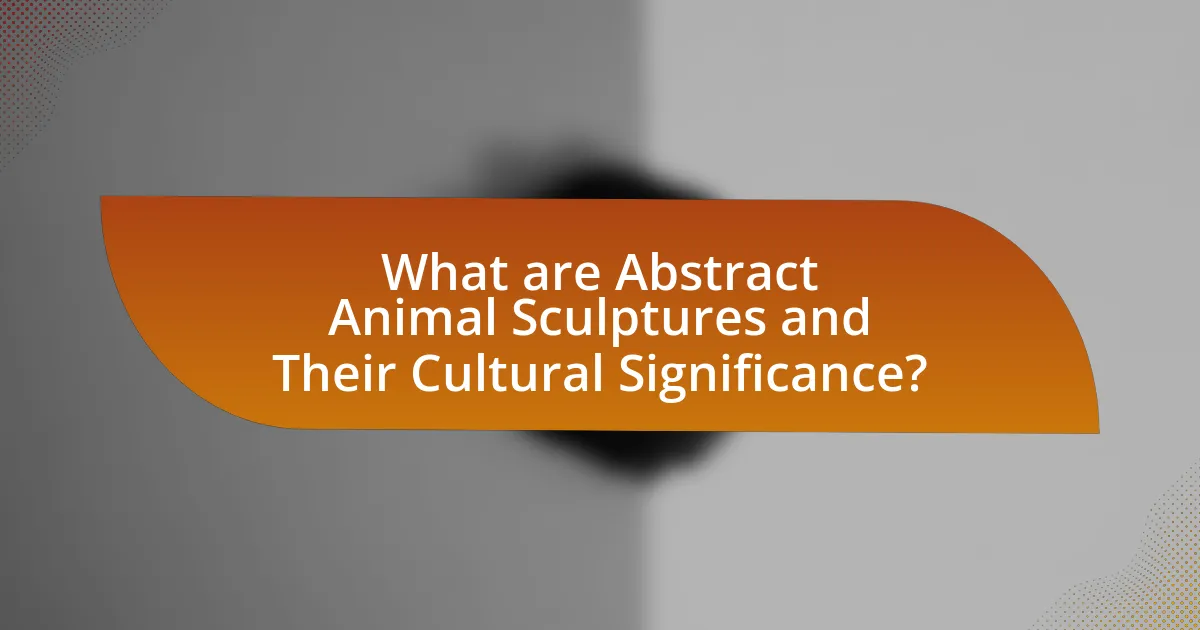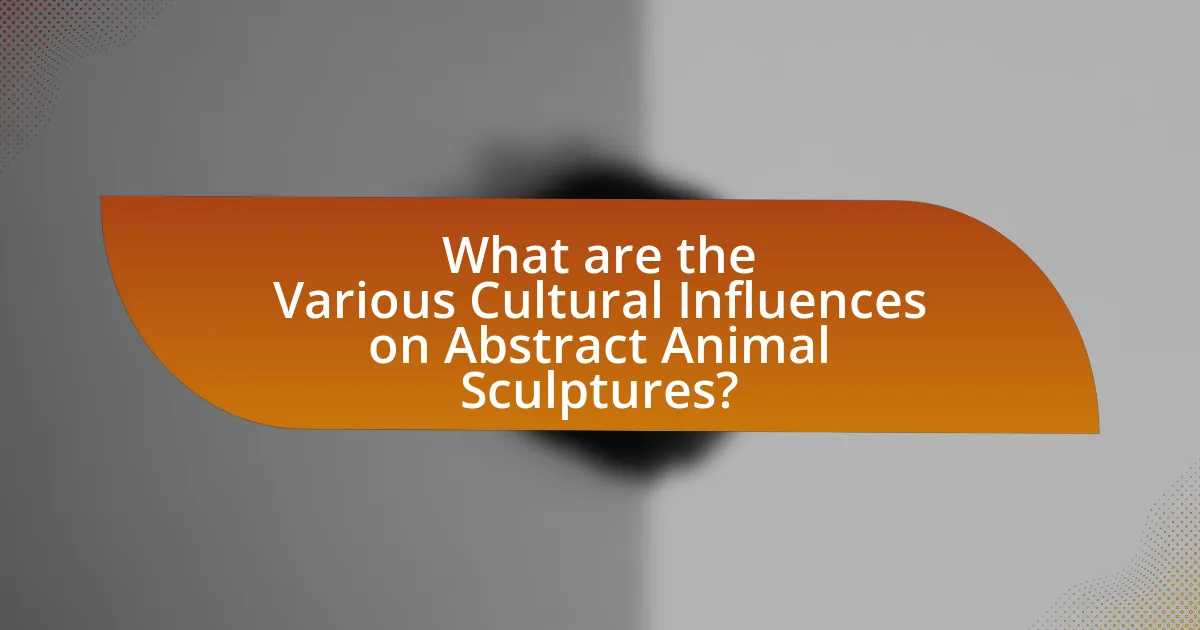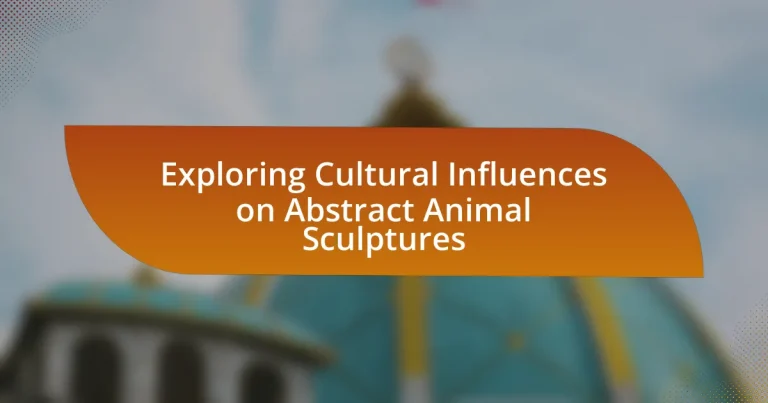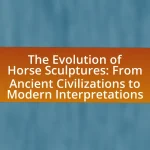Abstract animal sculptures are artistic representations that emphasize the essence of animals through simplification and exaggeration, reflecting the cultural values and beliefs of the societies that create them. This article explores the cultural significance of these sculptures, examining how different cultures interpret animal forms, the symbolic meanings associated with them, and the impact of globalization on their evolution. It also discusses the influence of indigenous art on contemporary practices, the challenges of maintaining cultural authenticity, and practical tips for analyzing and appreciating these artworks. Notable examples and recognized artists in the genre are highlighted to illustrate the fusion of culture and abstraction in animal sculpture.

What are Abstract Animal Sculptures and Their Cultural Significance?
Abstract animal sculptures are artistic representations that simplify or exaggerate the forms of animals, focusing on their essence rather than realistic details. These sculptures often convey cultural meanings, reflecting the values, beliefs, and aesthetics of the societies that create them. For instance, in many Indigenous cultures, abstract animal forms symbolize spiritual connections to nature and the environment, serving as totems or protective figures. The significance of these sculptures can be seen in their use in rituals, storytelling, and as expressions of identity, illustrating how art can encapsulate and communicate complex cultural narratives.
How do cultural contexts shape the creation of abstract animal sculptures?
Cultural contexts significantly shape the creation of abstract animal sculptures by influencing the themes, materials, and stylistic choices artists make. For instance, in African cultures, animal forms often symbolize spiritual beliefs and community values, leading to sculptures that reflect these deeper meanings, such as the use of specific animals representing ancestral spirits. In contrast, Western abstract sculptures may prioritize form and aesthetics over symbolic representation, focusing on the emotional response elicited by the artwork rather than cultural narratives. Historical examples include the use of totemic figures in Indigenous cultures, which serve as cultural markers and convey stories, while modernist movements in Europe emphasize abstraction and experimentation with materials. Thus, the cultural background of the artist and the societal values at play directly inform the artistic expression found in abstract animal sculptures.
What cultural symbols are often represented in these sculptures?
Cultural symbols often represented in abstract animal sculptures include totems, deities, and mythological creatures. These symbols reflect the beliefs and values of the cultures from which the sculptures originate. For instance, totem poles in Indigenous cultures symbolize ancestral lineage and spiritual guidance, while sculptures of deities often represent specific attributes or powers associated with those figures, such as fertility or protection. Additionally, mythological creatures, like dragons in Asian cultures, embody concepts such as strength and wisdom. These representations serve to convey cultural narratives and reinforce community identity.
How do different cultures interpret animal forms in abstraction?
Different cultures interpret animal forms in abstraction through unique symbolic meanings and artistic styles. For instance, in African art, animals often represent spiritual beliefs and ancestral connections, leading to stylized forms that emphasize specific traits, such as strength or wisdom. In contrast, Japanese abstract representations of animals, like the crane or koi fish, often embody concepts of longevity and perseverance, reflecting cultural values and aesthetics. Additionally, Native American art frequently utilizes animal forms to convey stories and teachings, with abstraction serving to highlight the essence of the animal rather than its literal appearance. These interpretations are rooted in each culture’s historical context, belief systems, and artistic traditions, demonstrating how abstraction serves as a medium for deeper cultural expression.
Why are animals chosen as subjects in abstract sculpture?
Animals are chosen as subjects in abstract sculpture primarily due to their symbolic significance and the emotional connections they evoke in viewers. The representation of animals allows artists to explore themes such as nature, spirituality, and the human condition, making them versatile subjects in artistic expression. For instance, many cultures have historically associated specific animals with particular traits or values, such as strength, wisdom, or freedom, which can be abstractly interpreted in sculpture. This cultural symbolism enhances the depth of the artwork, inviting viewers to engage with the piece on multiple levels. Additionally, the organic forms of animals provide a rich source of inspiration for abstract interpretations, allowing artists to experiment with shapes, textures, and materials while still conveying recognizable forms.
What emotional or symbolic meanings do animals convey in art?
Animals in art convey a range of emotional and symbolic meanings, often representing concepts such as strength, freedom, and spirituality. For instance, lions symbolize courage and power, while doves are associated with peace and purity. Historical contexts reveal that different cultures attribute specific meanings to animals; for example, in ancient Egyptian art, cats were revered as symbols of protection and fertility. This cultural significance enhances the emotional resonance of animal representations, allowing viewers to connect with deeper themes of human experience and nature.
How do abstract representations differ from realistic portrayals of animals?
Abstract representations of animals simplify and stylize forms, focusing on essential characteristics rather than accurate details, while realistic portrayals aim to depict animals as they appear in nature, capturing their physical features and behaviors. For instance, abstract sculptures may use geometric shapes and bold colors to convey the essence of an animal, whereas realistic sculptures strive for lifelike accuracy, often requiring detailed observation and craftsmanship. This distinction highlights how cultural influences shape artistic expression, with abstract art often reflecting broader themes or emotions, while realism emphasizes fidelity to the subject.

What are the Various Cultural Influences on Abstract Animal Sculptures?
Various cultural influences on abstract animal sculptures include indigenous traditions, religious symbolism, and contemporary artistic movements. Indigenous cultures often incorporate animals as spiritual symbols, reflecting their connection to nature and belief systems, as seen in Native American totem poles. Religious influences manifest in sculptures that depict animals as representations of deities or moral lessons, such as the use of elephants in Hindu art symbolizing wisdom. Contemporary movements, like modernism and postmodernism, challenge traditional forms and meanings, leading to innovative interpretations of animal forms that reflect societal issues or personal expression. These influences demonstrate how cultural contexts shape the creation and interpretation of abstract animal sculptures.
How does indigenous art influence contemporary abstract animal sculptures?
Indigenous art significantly influences contemporary abstract animal sculptures by incorporating traditional motifs, symbolism, and techniques that reflect cultural narratives. Artists often draw inspiration from the spiritual and ecological relationships depicted in indigenous art, which emphasizes the interconnectedness of nature and animals. For example, the use of totemic forms and stylized representations in indigenous art can be seen in the works of contemporary sculptors who reinterpret these elements in a modern context, creating pieces that resonate with both cultural heritage and contemporary aesthetics. This blending of traditional and modern practices not only honors indigenous cultures but also enriches the contemporary art landscape by introducing diverse perspectives and techniques.
What specific techniques or styles are borrowed from indigenous cultures?
Indigenous cultures have contributed specific techniques and styles such as totem carving, weaving, and pottery to contemporary art forms. For instance, totem carving, prevalent among Native American tribes, involves intricate woodwork that tells stories and represents clan lineage, influencing modern sculptural practices. Weaving techniques from cultures like the Navajo and Maori have inspired contemporary textile artists to incorporate traditional patterns and methods into their work. Additionally, pottery styles from indigenous groups, such as the Pueblo peoples, emphasize functional art with unique glazing techniques, impacting modern ceramic practices. These borrowed techniques and styles reflect a deep respect for cultural heritage and craftsmanship, showcasing the ongoing influence of indigenous artistry in contemporary abstract animal sculptures.
How do indigenous beliefs about animals manifest in abstract forms?
Indigenous beliefs about animals manifest in abstract forms through symbolism and representation in art, reflecting cultural values and spiritual connections. For instance, many indigenous cultures view animals as totems or spiritual guides, which influences their artistic expressions, leading to abstract sculptures that embody these relationships. The use of geometric shapes and stylized forms in these sculptures often symbolizes specific traits or stories associated with the animals, such as strength, wisdom, or protection. This artistic approach is evident in the works of various indigenous artists, who incorporate traditional motifs and narratives into their abstract representations, thereby preserving and communicating their cultural heritage.
What role does globalization play in the evolution of abstract animal sculptures?
Globalization significantly influences the evolution of abstract animal sculptures by facilitating the exchange of artistic ideas and techniques across cultures. This interconnectedness allows artists to draw inspiration from diverse traditions, leading to innovative forms and styles that blend various cultural elements. For instance, the rise of international art fairs and online platforms has enabled artists from different backgrounds to showcase their work globally, resulting in a fusion of aesthetics that reflects a broader range of influences. Additionally, the accessibility of materials and resources across borders has expanded the creative possibilities for sculptors, allowing for experimentation with new forms and mediums. This dynamic interplay of cultural exchange and artistic collaboration underscores the transformative impact of globalization on the development of abstract animal sculptures.
How do cross-cultural exchanges impact artistic styles and themes?
Cross-cultural exchanges significantly influence artistic styles and themes by facilitating the blending of diverse cultural elements and ideas. This interaction leads to the incorporation of various techniques, motifs, and narratives from different traditions, resulting in innovative artistic expressions. For example, the Silk Road enabled the exchange of artistic practices between East and West, which can be seen in the fusion of Chinese and Persian art styles during the Tang Dynasty. Such historical instances illustrate how cross-cultural interactions enrich artistic landscapes, allowing artists to explore new themes and aesthetics that reflect a globalized perspective.
What are the challenges of maintaining cultural authenticity in a globalized art world?
Maintaining cultural authenticity in a globalized art world presents significant challenges, primarily due to the homogenization of artistic expressions and the dilution of local traditions. Globalization facilitates the widespread dissemination of art, often leading to the appropriation of cultural symbols without proper context or understanding, which can undermine the original meanings and significance of those symbols. For instance, artists may adopt traditional motifs from various cultures to appeal to a broader audience, risking the loss of their unique cultural narratives. Additionally, the commercialization of art in a global market can pressure artists to conform to mainstream trends, further eroding the authenticity of their cultural expressions. This phenomenon is evident in the art market, where works that resonate with global tastes often overshadow those that reflect specific cultural identities, leading to a cycle where authentic cultural representations are marginalized.

How Can We Analyze and Appreciate Abstract Animal Sculptures?
To analyze and appreciate abstract animal sculptures, one should examine the form, materials, and cultural context of the artwork. The form reveals the artist’s interpretation of the animal, often emphasizing specific features or emotions rather than realistic representation. Materials, such as metal, wood, or stone, contribute to the sculpture’s texture and visual impact, influencing how the piece is perceived. Cultural context is crucial; understanding the symbolism associated with the depicted animal in various cultures can enhance appreciation. For instance, in many Indigenous cultures, animals represent spiritual guides, which can inform the viewer’s interpretation of the sculpture’s meaning. This multifaceted approach allows for a deeper understanding and appreciation of abstract animal sculptures.
What are the key elements to consider when evaluating these sculptures?
The key elements to consider when evaluating abstract animal sculptures include form, material, cultural context, and emotional impact. Form refers to the shape and structure of the sculpture, which can convey movement or stillness, while material influences the texture and durability, affecting the overall aesthetic. Cultural context is crucial, as it provides insight into the symbolism and significance of the animal representation within a specific culture, often reflecting societal values or beliefs. Emotional impact relates to the viewer’s response, which can be influenced by the sculpture’s design and the cultural narratives it embodies. These elements collectively contribute to a comprehensive understanding of the sculpture’s artistic and cultural significance.
How do form, texture, and color contribute to the overall impact of the sculpture?
Form, texture, and color significantly enhance the overall impact of a sculpture by influencing its visual appeal and emotional resonance. The form of a sculpture defines its shape and structure, which can evoke specific feelings or ideas; for instance, a smooth, rounded form may convey softness and harmony, while sharp, angular forms can suggest tension or aggression. Texture adds depth and tactile quality, allowing viewers to engage with the piece on a sensory level; rough textures can evoke a sense of rawness or naturalism, while polished surfaces may suggest refinement and elegance. Color plays a crucial role in setting the mood and attracting attention; vibrant colors can energize a piece, while muted tones may evoke calmness or nostalgia. Together, these elements create a cohesive visual language that communicates the artist’s intent and cultural context, as seen in various abstract animal sculptures that reflect specific cultural narratives and emotional experiences.
What role does the viewer’s cultural background play in interpretation?
The viewer’s cultural background significantly influences interpretation by shaping perceptions, values, and emotional responses to art. Cultural context provides a framework through which individuals understand symbols, themes, and aesthetics in abstract animal sculptures. For instance, a viewer from a culture that reveres animals may interpret a sculpture as a representation of spirituality or connection to nature, while someone from a different background might see it merely as an artistic form. Research indicates that cultural experiences affect cognitive processing and emotional engagement with art, as demonstrated in studies like “Cultural Differences in Art Perception” by Choi et al., published in the Journal of Cross-Cultural Psychology, which highlights how cultural upbringing alters aesthetic appreciation and meaning-making in art.
What are some notable examples of abstract animal sculptures across cultures?
Notable examples of abstract animal sculptures across cultures include the “Kachina Dolls” from the Hopi tribe in the United States, which represent various animals and spirits in a stylized form, and the “Ndebele House Post” sculptures from South Africa, which often feature abstract representations of animals in vibrant colors. Additionally, the “Chinese Zodiac Animals” in various artistic forms, such as jade carvings, abstractly depict animals like the dragon and tiger, symbolizing different traits and characteristics. These examples illustrate how different cultures utilize abstraction to convey meanings and beliefs associated with animals, reflecting their unique cultural narratives and artistic traditions.
Which artists are recognized for their contributions to this genre?
Artists recognized for their contributions to the genre of abstract animal sculptures include Henry Moore, Barbara Hepworth, and Alexander Calder. Henry Moore is celebrated for his large-scale abstract forms that often incorporate animal motifs, reflecting organic shapes and natural forms. Barbara Hepworth’s work features simplified, abstract representations of animals, emphasizing form and texture, while Alexander Calder is known for his kinetic sculptures that often include abstracted animal figures, showcasing movement and balance. These artists have significantly influenced the genre through their innovative approaches and unique interpretations of animal forms.
What specific works exemplify the fusion of culture and abstraction in animal sculpture?
Specific works that exemplify the fusion of culture and abstraction in animal sculpture include Alberto Giacometti’s “The Walking Man” and Henry Moore’s “Reclining Figure.” Giacometti’s piece reflects existential themes and the human condition through the abstraction of a human figure, while also drawing on cultural influences from his Swiss heritage. Moore’s work incorporates organic forms and abstract representations of animals, influenced by prehistoric art and the natural landscape of England. Both artists demonstrate how cultural contexts shape abstract interpretations of animal forms, merging traditional motifs with modernist abstraction.
What practical tips can enhance the appreciation of abstract animal sculptures?
To enhance the appreciation of abstract animal sculptures, viewers should engage in active observation and interpretation. This involves taking time to examine the shapes, materials, and textures used in the sculptures, which can reveal the artist’s intent and cultural influences. For instance, understanding the symbolism behind certain animal forms in various cultures can deepen appreciation; for example, in many Indigenous cultures, animals represent spiritual guides or traits. Additionally, discussing the sculptures with others can provide diverse perspectives and insights, enriching the overall experience. Engaging with the context of the artwork, such as the artist’s background and the cultural significance of the depicted animals, further enhances understanding and appreciation.


